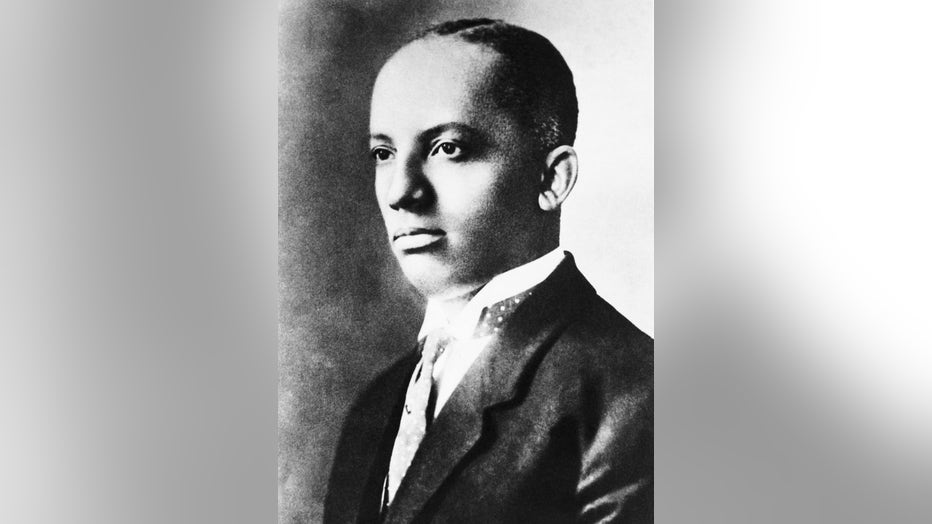Black History Month 2024 theme: African Americans’ influence on the arts in the US

File: American jazz musician Louis Armstrong (1901 - 1971) (center right, in dark suit) smiles as he poses on stage with a band for the WMSB radio station in New Orleans, Louisiana, 1920s. (Photo by Transcendental Graphics/Getty Images)
Feb. 1 marks the beginning of Black History Month in the United States and every year the Association for the Study of African American Life and History (ASALH) chooses a different theme.
This year’s theme highlights African Americans and the arts.
From visual and performing arts, literature, fashion, folklore, language, music and film, Black artists have used their creative outlets to preserve and share their history and instill empowerment in their communities.
"Artistic and cultural movements such as the New Negro, Black Arts, Black Renaissance, hip-hop, and Afrofuturism, have been led by people of African descent and set the standard for popular trends around the world. In 2024, we examine the varied history and life of African American arts and artisans," the ASLAH said.
How did Black History Month start?

File: Carter Goodwin Woodson (1875-1950), African-American historian, is shown in a head and shoulders portrait. (Bettmann via Getty Images)
Carter G. Woodson, a founder of the ASALH organization, first came up with the idea of the celebration that became Black History Month.
Woodson, born in 1875 to recently freed Virginia slaves, went on to earn a Ph.D. in history from Harvard. He worried that Black children were not being taught about their ancestors’ achievements in American schools in the early 1900s.
"Woodson fervently believed that Black people should be proud of their heritage and all Americans should understand the largely overlooked achievements of Black Americans," the NAACP states on its website.
Woodson originally came up with the idea of Negro History Week to encourage black Americans to become more interested in their own history and heritage and it was established in 1926.
Why is Black History Month in February?
Woodson chose February for Negro History Week because it had the birthdays of President Abraham Lincoln and Frederick Douglass. Lincoln was born on Feb. 12, and Douglass, a former slave who did not know his exact birthday, celebrated his on Feb. 14.
The first Negro History Week was announced in February 1926.
RELATED: Slavery reparations: How the US can follow one town's effort to right dark past
When did the celebration expand from a week to a month?
Individually several places, including West Virginia in the 1940s and Chicago in the 1960s, expanded the celebration into Negro History Month, according to the Associated Press. The civil rights and Black Power movement advocated for an official shift from Black History Week to Black History Month.
In 1976, 50 years after the first celebration, the ASALH officially shifted from a week to a month and from "Negro history" to "Black history." Since the mid-1970s, every U.S. president — Democrat and Republican — has issued proclamations honoring the spirit of Black History Month and endorsing the organization’s annual theme.
RELATED: Black History Month: When and how it got started
African Americans and the arts

File: American Blues musician Muddy Waters (born McKinley Morganfield, 1913 - 1983) plays an electric guitar as he performs onstage during the 'Foghat Blues Tribute' concert at the Palladium, New York, New York, September 30, 1977. (Photo by Gary Ger
For centuries, African Americans have birthed art as a result of their experience in the U.S., according to the ASALH.
Prior to the American Revolution, enslaved Africans would showcase their visual artistry through crafts such as sweetgrass basket weaving and sang spirituals which would become the country’s first contributions to music.
Musicians such as Robert Johnson, McKinley "Muddy Waters" Morganfield and Riley "BB" B. King would go on to create the foundation for music genres that are integral for much of the music we hear today.
What’s more, influences from Black poets, writers, and sculptors can be found throughout history, including works from Phillis Wheatley, David Walker, Edmonia Lewis and more.

File: American poet and writer Langston Hughes (1902 - 1967), circa 1945. (Photo by Hulton Archive/Getty Images)
In the 1920s and 30s, Black art would be given an international spotlight thanks to the rise of the Black Renaissance and New Negro Movement, according to ASALH.
The emergence of artists such as Langston Hughes, James Reese Europe and Josephine Baker would make way for a cultural movement which would spread across the globe.
Further expressing pride in their culture, the Harlem Renaissance opened the door for Black artists to share their work and highlighted their hometowns such as Los Angeles, Chicago and New Orleans.

File: Portrait of painter Aaron Douglas (1899 - 1979), longtime professor at Fisk University and a leading figure in the Harlem Renaissance, painting at his easel, Tennessee, ca. 1970s. (Photo by Robert Abbott Sengstacke/Getty Images)
During the ‘60s and ‘70s, the Black Arts Movement and hip-hop burst onto the scene and brought artists such as Alvin Ailey, Judith Jamison, DJ Kool Herc, and many others to the forefront of music and performing arts.
RELATED: Early TV news coverage of rap & hip-hop
Today, the richness and history of African American culture continues to shine in all aspects of society, but especially in the arts.
"In celebrating the entire history of African Americans and the arts, the Association for the Study of African American Life and History (ASALH) puts into the national spotlight the richness of the past and present with an eye towards what the rest of the twenty-first century will bring," the ASALH said.
Kelly Hayes contributed to this report. This story was reported from Los Angeles.

